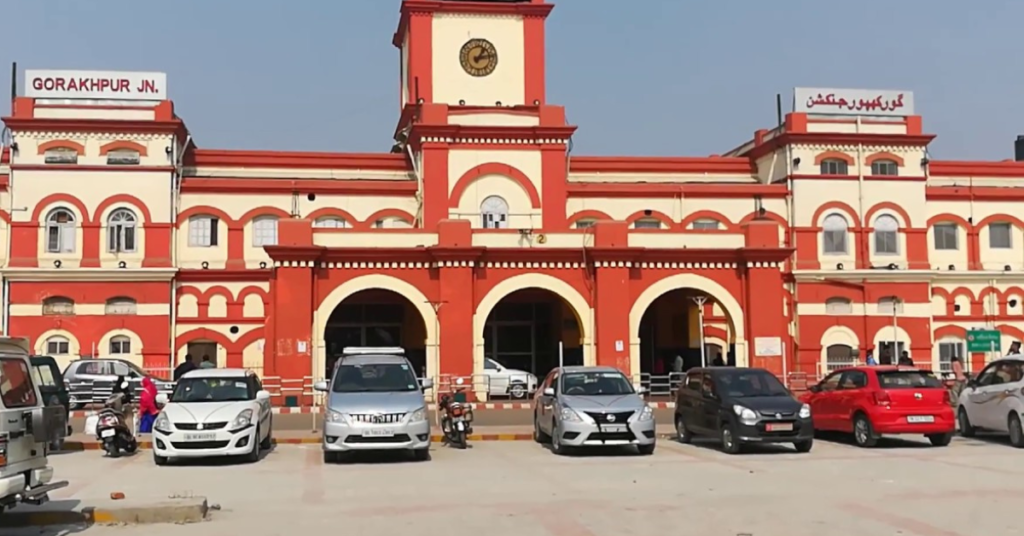Gorakhpur Railway Station and North Eastern Railways Headquarters: World’s No1 Largest plateform in gorakhpur

In the heart of the bustling city of Gorakhpur, the North Eastern Railways Headquarters and the Gorakhpur Railway Station stand as vital nodes in the vast and intricate web of India's railway network. Beyond their functional roles, these institutions weave together a tapestry of stories, journeys, and the rhythmic pulse of life on the move.
The North Eastern Railways (NER) Headquarters, centrally located in Gorakhpur, serves as the nerve center for railway operations across the northeastern region of India.Gorakhpur Railway Station has the largest platform in the world.
Established to streamline and manage the vast railway network that crisscrosses states like Uttar Pradesh, Bihar, and parts of West Bengal, NER and gorakhpur railway station plays a pivotal role in ensuring the smooth functioning of train services, maintenance, and overall railway infrastructure.
The architectural presence of the NER Headquarters mirrors the efficiency and orderliness inherent in railway operations. The sprawling complex houses administrative offices, control rooms, and facilities for coordinating train schedules, maintenance, and strategic planning.
The role of NER in the overall railway ecosystem is underscored by its role in facilitating the movement of people and goods, contributing significantly to the region’s economic development.
As a hub of strategic planning, NER Headquarters orchestrates the movement of trains, manages resources, and ensures the safety of passengers and cargo. The diligent work behind the scenes at the headquarters is a testament to the commitment of railway personnel who work tirelessly to keep the trains running on time and the tracks well-maintained.
Adjacent to the NER Headquarters, the Gorakhpur Railway Station is a gateway to the city and a witness to the ebb and flow of countless journeys. Renowned for being one of the busiest railway stations in the country, Gorakhpur Railway Station is not merely a transit point but a melting pot of diverse stories, cultures, and experiences.
The architecture of Gorakhpur Railway Station reflects a harmonious blend of functionality and aesthetics. The station, with its distinctive façade and imposing structures, is a visual landmark in the city. The bustling platforms, adorned with the vibrant hues of trains and the constant movement of passengers, create a lively tableau that captures the essence of the city’s dynamism.
Beyond the architectural features, the soul of Gorakhpur Railway Station lies in the symphony of sounds—the rhythmic chug of departing trains, the melodic announcement of arrivals, and the lively chatter of passengers. It is a microcosm of life on the move, where stories begin and unfold, and the platform becomes a stage for transient connections and farewells.
The railway tracks, extending like lifelines from Gorakhpur Railway Station, connect the city to various corners of the country. Trains departing from Gorakhpur traverse diverse landscapes, from northern India’s fertile plains to the rugged terrains of the northeastern states. The railway lines are conduits of connectivity, threading together the nation’s fabric in a journey that spans mountains, rivers, and vast expanses.
One of the distinctive features of Gorakhpur Railway Station is the Gorakhdham Express, a train that has become synonymous with the city. Connecting Gorakhpur to the national capital, New Delhi, the Gorakhdham Express is not just a mode of transportation but a cultural symbol, embodying the spirit of Gorakhpur’s resilience and connectivity to the broader world.
The railway platforms at Gorakhpur are animated spaces where a kaleidoscope of humanity unfolds. From the hurried footsteps of commuters rushing to catch a train to the leisurely pace of families embarking on a vacation, the platform is a theater of life’s comings and goings. Vendors peddle snacks and chai, adding to the sensory symphony of the railway station experience.
For many travelers, Gorakhpur Railway Station is a pitstop on their pilgrimage journey. The station serves as a gateway to the holy city of Varanasi and the revered temple town of Ayodhya. Pilgrims from various corners of the country pass through Gorakhpur, making it a transient haven for spiritual seekers en route to their sacred destinations.
The railway station is not just a place of transit but also a hub for cultural exchange. Passengers from different regions bring the flavors of their native cuisines, languages, and traditions. The platform becomes a cultural crossroads where diversity cheers daily, and the journey becomes a shared experience that transcends regional boundaries.
Gorakhpur Railway Station is a nodal point for trade and commerce, facilitating the movement of goods and commodities across the country. The railway yards are bustling with activity as goods trains are loaded and unloaded, ensuring the seamless flow of products that sustain economies and communities.
The railway colonies surrounding Gorakhpur Railway Station are a community, with railway personnel and their families creating a close-knit neighborhood. The symbiotic relationship between the railway station and its surroundings is evident in the shared history, traditions, and camaraderie that have evolved over the years.
In recent times, Gorakhpur Railway Station has undergone modernization initiatives to enhance passenger amenities and streamline operations. The introduction of digital ticketing, cleanliness drives, and improved waiting areas are steps towards making the railway experience more comfortable and efficient for passengers.
In conclusion, the North Eastern Railways Headquarters and Gorakhpur Railway Station encapsulate the spirit of connectivity and movement that defines the Indian railway system. Beyond transportation logistics, these institutions are integral to Gorakhpur‘s cultural, economic, and social fabric. As trains depart and arrive, as passengers embark on new journeys, and as the wheels of progress turn, the railways remain a lifeline that connects the city to the vast tapestry of the nation.